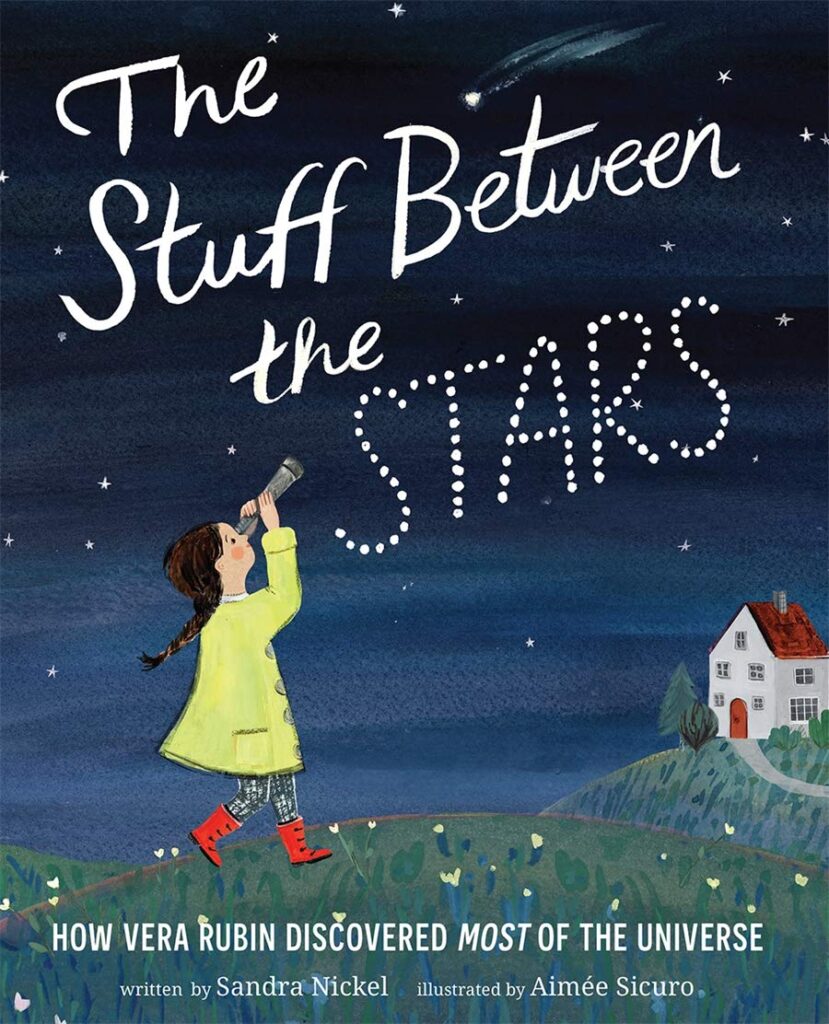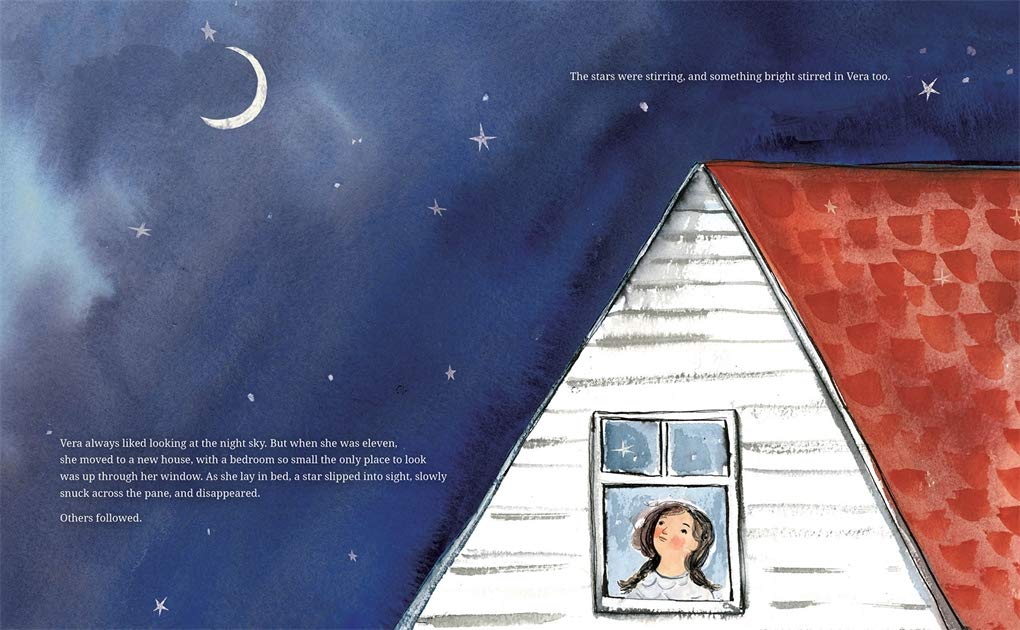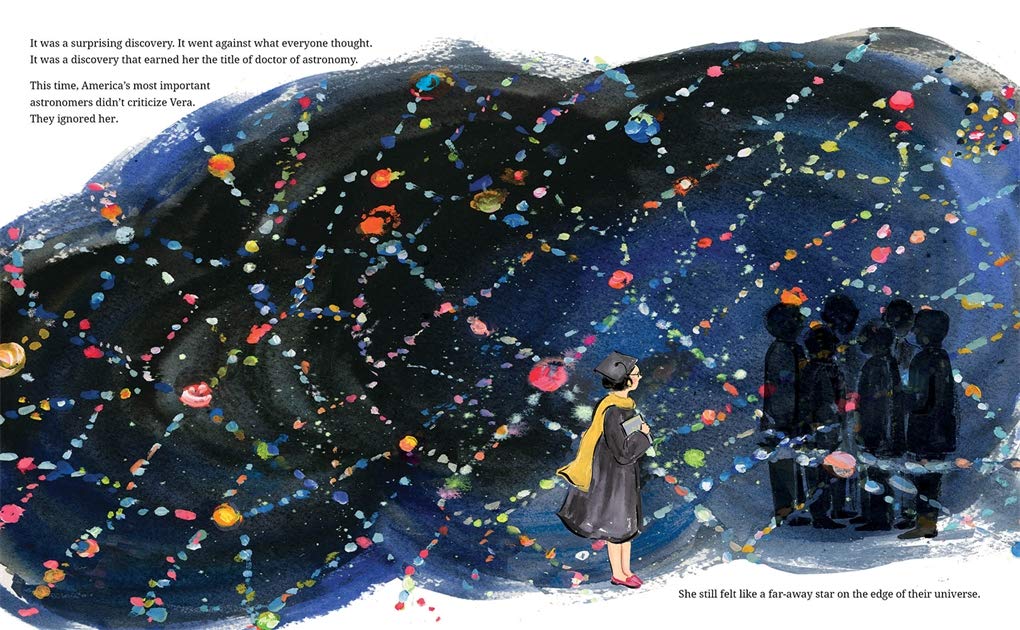Grey matter and dark matter walk into a bar. The bartender looks at them and asks, “what’s the matter?”. Dark says, “I’m not attracted to anybody”. It’s worth noting that I know absolutely nothing about dark matter and didn’t even know that it was an actual thing before I read The Stuff Between the Stars. The Stuff Between the Stars: How Vera Rubin Discovered Most of the Universe, is an excellent example of an intelligent, illustrated book that treats its young audience with respect and isn’t afraid to broach big-scale ideas. It does this and accomplishes what an illustrated book should do, which is to entertain young readers. As a healthy aside, those rare illustrated books will tell them something new and make them curious about the bigger picture.

The first thing readers will notice when they open The Stuff Between the Stars is the stark difference in its colors and the effective way that it uses the rule of thirds. A young Vera Rubin is in her room looking out the window into the night sky. She’s in the lower right page while the vast night sky takes up the entire left page. From a design perspective, the size disparity will give readers a hint of the scale that Rubin tried up end to prove.

Rubin grew up looking at the night sky and asking questions about how it all moved. She even had a homemade telescope in her bedroom that allowed her to see just a bit further. In the sky, she would track the North Star and other bodies and wonder about what was between all of those lit objects. Her high school counselor suggested that she pursue a career in art because astronomy was a man’s world.
Thankfully, she didn’t listen but kept running into roadblocks. She got married and loved her new life, but kept looking at the night sky. Rubin had the idea that galaxies rotate around the center and it stuck with her. Vera presented her ideas to various astronomers who unanimously said that her idea was ridiculous.

She kept looking at the stars, had another child, and did lots of calculations about how astral bodies moved. As her kids got older she started teaching astronomy in Washington, D. C.. During that time other astronomers heard about her wacky theory and were speaking to her about it. Little by little, she was able to gain access to advanced telescopes until she was able to photograph the Andromeda Galaxy.
After looking at these photographs she thought of this mysterious stuff that was between the stars. The ages of galaxies didn’t make a difference they all spun at the same speed from the center to its outer boundary. This was a paradigm shift for those astronomers because it proved that they had been looking at a fraction of what’s in space.
We love science books that are effective in teaching children about people in that field who made a difference. Vera Rubin certainly meets that criteria and The Stuff Between the Stars is an illustrated book that’s effective for elementary school readers all the way through early middle school.
Wha..? a middle school student reading the same illustrated book as an elementary student? Yes, granted those younger readers will need to have it read to them, whereas those surly 12-year-olds can read it themselves. The reason this works is that the art will keep them both engaged. The STEM content will make older kids want to read it and the underdog, the start-to-finish story of Vera Rubin is one that everybody will root for. The text by Sandra Nickel is dreamy, yet to the point when it needs to be, and tells the story in a way that’s not too much or lacking in detail. The book also has some author’s notes, a timeline of Rubin’s life, and a bibliography for those who want to read more about her.
The Stuff Between the Stars: How Vera Rubin Discovered Most of the Universe is written by Sandra Nickel with illustrations by Aimee Sicuro and available on Abrams Books for Young Readers, an imprint of Abrams Books.
There are affiliate links in this post.





 Facebook
Facebook Twitter
Twitter Flickr
Flickr GooglePlus
GooglePlus Youtube
Youtube